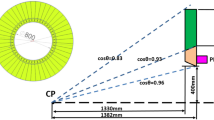Abstract
Purpose
The end cap time of flight (TOF) at Beijing spectrometer was upgraded with multi-gap resistive plate chamber technology in order to improve the particle identification capability in 2015. The offline data quality monitoring is a critical aspect of the data processing chain aiming at providing data with good quality for physics analyses.
Methods
An offline data quality monitoring tool for upgraded end cap TOF has been developed to provide feedback about the functioning and performance of detector hardware and data processing chain.
Results
Detector information and reconstructed time-of- flight characteristics of charged tracks are filled into plots using full Bhabha events reconstruction results, and then, these plots are used to assess the operational conditions of the detector and the quality of the data by the experts.
Conclusion
This paper is describing the design and the content of performance of the offline data quality monitoring of end cap TOF and the data quality performance achieved during last 2 years’ physical data taking.








Similar content being viewed by others
Change history
23 December 2021
A Correction to this paper has been published: https://doi.org/10.1007/s41605-021-00301-5
References
M. Ablikim et al., (BESIII Collaboration). Nucl. Instrum. Meth. A 614, 345–399 (2010)
M. Ablikim et al., (BESIII Collaboration). Nucl. Instrum. Meth. A 598, 7–11 (2009)
C. Zhang for BEPC&BEEPCII Teams, in Proceedings of APAC, pp. 15–19, Gyeongju, Korea (2004)
Qin Gang et al., Chin. Phys. C 32, 1–8 (2018)
Y.K. Heng et al., IEEE Nucl. Sci. Symp. Conf. Rec., pp. 53–57 (2007)
C. Wu et al., Nucl. Instrum. Meth. A 555, 142–147 (2005)
Sun Zhi-Jia et al., High Energy Phys. Nucl. Phys. 29(10), 933–937 (2005). (in Chinese)
S.H. An et al., Meas. Sci. Technol. 17, 2650–2654 (2006)
E.C. Zeballos et al., Nucl. Instrum. Meth. A 374, 132–136 (1996)
M.C.S. Williams et al., (ALICE Collaboration). Nucl. Phys. A 698, 464–467 (2001)
P. Fonte et al., Nucl. Instrum. Meth. A 449, 295–301 (2000)
A. Akindinov et al., Nucl. Instrum. Meth. A 602, 821–824 (2009)
Sun Yong-Jie et al., Chin. Phys. C (HEP&NP) 36, 429–433 (2012)
S. Yang et al., Nucl. Instrum. Meth. A 76, 190–196 (2014)
H. Fan et al., IEEE Trans. Nucl. Sci. 60, 3563 (2013)
Xin Li et al., Radiat. Detect. Technol. Methods 1, 13 (2017)
D. De Gruttola et al., Nucl. Instrum. Meth. A 661, S102–S105 (2012)
A. Alici et al., Nucl. Instrum. Meth. A 706, 29–32 (2013)
F. Geurts et al., Nucl. Instrum. Meth. A 533, 60–64 (2004)
W.J. Llope, Nucl. Instrum. Meth. A 241, 306–310 (2005)
Ying-Xiao Guo et al., Radiat. Detect. Technol. Methods 1, 15 (2017)
R.X. Yang et al., JINST 12, C01012 (2017)
Xihui Chen et al., Nucl. Instrum. Meth. A 592, 428–433 (2008)
Xie Xiao-Xi et al., Nucl. Electron. Detect. Technol. 26, 291–295 (2006). (in Chinese)
Zhang Yin-Hong et al., Nucl. Electron. Detect. Technol. 28, 744–748 (2008). (in Chinese)
Li Fei et al., Nucl. Electron. Detect. Technol. 27, 462–465 (2007). (in Chinese)
Hu Ji-Feng et al., Chin. Phys. C (HEP&NP) 36, 62–66 (2012)
Sun Xiao-Dong et al., Chin. Phys. C (HEP&NP) 36, 622–627 (2012)
X.Z. Wang et al., Chin. Phys. C 41, 016103 (2017)
Z. Wu et al., JINST 11, C07005 (2016)
X.Z. Wang et al., Eur. Phys. J. C 76, 211 (2016)
X. Ma et al., High Energy Phys. Nucl. Phys. 32, 744–749 (2008)
S. Agostinelli et al., (GEANT4 Collaboration). Nucl. Instrum. Meth. A 506, 250–303 (2003)
L.L. Wang et al., High Energy Phys. Nucl. Phys. 31, 183–188 (2007). (in Chinese)
J.K. Wang et al., Chin. Phys. C (HEP&NP) 33, 870–879 (2009)
J. Yan et al., Chin. Phys. C (HEP&NP) 34, 368–373 (2010)
C.D. Fu et al., Chin. Phys. C (HEP&NP) 32, 329–337 (2008)
W.D. Li, et al., Int. Conf. Comput. High Energy Nucl. Phys. 1, 225–228 (2006)
G. Barrand, et al., Comput. Phys. Commun. 140 45 (2001); http://proj-gaudi.web.cern.ch/proj-gaudi
Acknowledgements
The authors would like to thank the tremendous efforts of the BESIII ETOF group. This work is supported in part by the CAS center for Excellence in Particle Physics (CCEPP).
Author information
Authors and Affiliations
Corresponding author
Additional information
Supported in part by National Natural Science Foundation of China (11575225, 11875277, U1232201, 11605220, U1832204), National Key Basic Research Program of China (2015CB856700), Chinese Academy of Sciences (1G201331231172010).
Rights and permissions
About this article
Cite this article
Ma, MM., Liu, JY., Wen, SP. et al. The offline data quality monitoring of the BESIII end cap TOF system. Radiat Detect Technol Methods 3, 58 (2019). https://doi.org/10.1007/s41605-019-0132-0
Received:
Revised:
Accepted:
Published:
DOI: https://doi.org/10.1007/s41605-019-0132-0




